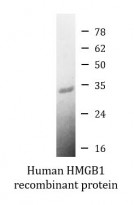ARG70220
Human HMGB1 recombinant protein (Active) (His-tagged, C-ter)
Human HMGB1 recombinant protein (Active) (His-tagged, C-ter) for SDS-PAGE
Overview
| Product Description | E. coli expressed, His-tagged (C-ter) Active Human HMGB1 recombinant protein |
|---|---|
| Tested Application | SDS-PAGE |
| Target Name | HMGB1 |
| Species | Human |
| A.A. Sequence | Met1 - Glu215 |
| Expression System | E. coli |
| Activity | Active |
| Activity Note | Determined by its ability to induce TNF alpha in RAW264.7 cells. The ED50 for this effect is < 10 μg/mL. |
| Alternate Names | HMG-1; High mobility group protein B1; High mobility group protein 1; HMG1; SBP-1; HMG3 |
Properties
| Form | Powder |
|---|---|
| Purification Note | Endotoxin level is less than 0.1 EU/µg of the protein, as determined by the LAL test. |
| Purity | > 98% (by SDS-PAGE) |
| Buffer | PBS (pH 8.0) |
| Reconstitution | It is recommended to reconstitute the lyophilized protein in sterile water to a concentration not less than 200 μg/mL and incubate the stock solution for at least 20 min at room temperature to make sure the protein is dissolved completely. |
| Storage Instruction | For long term, lyophilized protein should be stored at -20°C or -80°C. After reconstitution, aliquot and store at -20°C or -80°C for up to one month. Storage in frost free freezers is not recommended. Avoid repeated freeze/thaw cycles. Suggest spin the vial prior to opening. |
| Note | For laboratory research only, not for drug, diagnostic or other use. |
Bioinformation
| Gene Symbol | HMGB1 |
|---|---|
| Gene Full Name | high mobility group box 1 |
| Background | HMGB1 is a protein that belongs to the High Mobility Group-box superfamily. The encoded non-histone, nuclear DNA-binding protein regulates transcription, and is involved in organization of DNA. This protein plays a role in several cellular processes, including inflammation, cell differentiation and tumor cell migration. Multiple pseudogenes of this gene have been identified. Alternative splicing results in multiple transcript variants that encode the same protein. [provided by RefSeq, Sep 2015] |
| Function | HMGB1 is a DNA binding protein. It associates with chromatin and has the ability to bend DNA. Binds preferentially single-stranded DNA. Involved in V(D)J recombination by acting as a cofactor of the RAG complex. Acts by stimulating cleavage and RAG protein binding at the 23 bp spacer of conserved recombination signal sequences (RSS). [UniProt] |
| Cellular Localization | Nucleus. Chromosome. Cytoplasm. Secreted. Cell membrane; Peripheral membrane protein; Extracellular side. Endosome. Endoplasmic reticulum-Golgi intermediate compartment. Note=In basal state predominantly nuclear. Shuttles between the cytoplasm and the nucleus. Translocates from the nucleus to the cytoplasm upon autophagy stimulation. Release from macrophages in the extracellular milieu requires the activation of NLRC4 or NLRP3 inflammasomes. [UniProt] |
| Highlight | Related products: HMGB1 antibodies; HMGB1 ELISA Kits; HMGB1 Duos / Panels; HMGB1 recombinant proteins; Related news: HMGB1, a biomarker and therapeutic target in COVID-19 Total solution for HMGB1 research HMGB1 in inflammation Inflammatory Cytokines HMGB1 ELISA Kit for your research Detecting the DAMPs in cancer therapy by HMGB1 ELISA kit New HMGB1 neutralizing antibody is released Detecting exosomal HMGB1 for ICD research Inducing M2 polarization, a surprising function of HMGB1 Related poster download: HMGB1 Pathway.pdf |
| PTM | Phosphorylated at serine residues. Phosphorylation in both NLS regions is required for cytoplasmic translocation followed by secretion (PubMed:17114460). Acetylated on multiple sites upon stimulation with LPS (PubMed:22801494). Acetylation on lysine residues in the nuclear localization signals (NLS 1 and NLS 2) leads to cytoplasmic localization and subsequent secretion (By similarity). Acetylation on Lys-3 results in preferential binding to DNA ends and impairs DNA bending activity (By similarity). Reduction/oxidation of cysteine residues Cys-23, Cys-45 and Cys-106 and a possible intramolecular disulfide bond involving Cys-23 and Cys-45 give rise to different redox forms with specific functional activities in various cellular compartments: 1- fully reduced HMGB1 (HMGB1C23hC45hC106h), 2- disulfide HMGB1 (HMGB1C23-C45C106h) and 3- sulfonyl HMGB1 (HMGB1C23soC45soC106so). Poly-ADP-ribosylated by PARP1 when secreted following stimulation with LPS (By similarity). In vitro cleavage by CASP1 is liberating a HMG box 1-containing peptide which may mediate immunogenic activity; the peptide antagonizes apoptosis-induced immune tolerance (PubMed:24474694). Can be proteolytically cleaved by a thrombin:thrombomodulin complex; reduces binding to heparin and proinflammatory activities (By similarity). [UniProt] |
Images (1) Click the Picture to Zoom In






